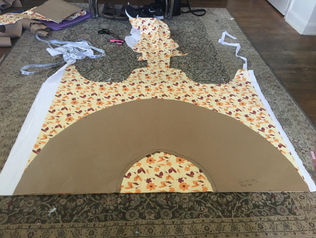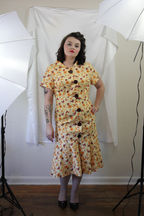
Agnes outside her restaurant: The Boulevard
Agnes Eriksen was born Agnes Olsen in 1910. And lived in Portland most her life.
My Great Aunt Agnes was many things in her lifetime. She was a restaurant owner, a socialite, a traveler, a mother.. and a lover of high fashion. And while she wasn't a fashion designer, per se, she did spend a couple years in the 1950's designing and creating clothing.
Her 1950's design sketchbooks were preserved and passed on to me. And while I cannot find evidence of the garments she made, I will try to capture this snapshot of her life through recreating her work.
September 1954
This dress was created in September of 1954, her first pattern in her books. Based on the fabric and season this was likely a day dress as it is casual and there are not many holidays or gatherings that happen in late September when this dress would likely have been completed. The silhouette is fitted with pleats and gathering for ease of movement and to give areas of added fullness. A couple key styles that carry throughout her designs that are seen in this one is the dolman style sleeve, high bust line that is sectioned from the bodice and gathered to add fullness, and a shawl collar.
January 22, 1955
Jumping from 1954 to 1955 Agnes began the year designing this turquoise coat. Like ideas explored in the literature review of the reinvention of 1920’s styles in the 50’s, this coat is meant to be large and boxy on a fitted silhouette. But instead of the long sleeves in the 20’s this coat has wide cropped sleeves, presumably to show off the style of gloves worn with it.
February 1955
In February of the same year she began designing this 8-gore dress. This is not her first flare dress designed in this book, but it is the first one that is recreated for this project. This dress would most likely be worn with a petticoat to support the flare of the dress, or she could have soaked the dress in sugar water or starch to make the skirt crisper.
March 1, 1955
This periwinkle blue dress was designed in March, presumably as a day dress. This dress does not seem to be included in her “Costume Either” at the beginning of this book, but I believe it is referenced in the beginning of her second as the “Blue linen” dress. There she pairs it with a yellow bolero, a white hat, black gloves, black patent leather shoes, and a black bag. This list was created in December of 55’ which might make sense of how she paired many dark accessories with a light dress designed in the spring.
March 8, 1955
Another garment from March of the same year is this bouclé wool coat. This garment feels more formal, with a large lapel/collar, and oversized cuffs. The small and bold details within this design would make it more of a showstopper piece, in a casual closet. This coat is also form-fitted, differing from the January coat, which may show how it is less of a functional piece for warmth or to carry items, but as purely a style piece.
March 29, 1955
In 1955 Easter was on April 10th, and based on the formal look of this dress, and Agnes’ fabric choice, this dress could have been for the holiday. In April of this year she added a ribbon swatch to add to a blue hat (See image below), which she most likely created as she lists a frame and “bregaro” yardage, tricot covering, a braid (meaning the ribbon), and a rose.
March- April 1955
This dress is created without a date but was designed sometime between March and April, as those are the dates of the garments surrounding this one. This dress is shorter and less mature than previous garments. This could mean that this dress was for Agnes’ daughter, Anne, or it could have just been for sporting events as it is short and sleeveless. There is another possibility that her garments were only designs and not finished garments, as she was using these sketchbooks for a class she was taking. Oftentimes for a design student, they practice creating a design laying out the pattern pieces like she has done here, without cutting and sewing the garment. This possibility seems less likely as she has the swatch and costs for materials listed.
May 1955
Fast forwarding to May of 1955, Agnes designs this sleek geometric dress. The silky fabric and long skirt create a formal look, while the cap sleeves and geometric bodice design keeps the dress casual and playful.
October 4, 1955
October 4th of 1955, Agnes designed this simple tapered skirt, reminiscent of her dress design in May of the same year. This skirt is longer and made with a wool and silk fabric for the cooler fall weather.
November 1955
November of 1955 Agnes designed this shaped floral blouse. This blouse follows trends from this time, with narrow sloping shoulders, a tight waistline, and material flaring at the hips. Like Agnes Eriksen’s other designs, fullness is added to the bustline, to help create the classic 1950’s hourglass shape.
January 1956
To begin the year of 1956, Agnes creates this suit jacket that goes with a contrasting skirt (see next design). This jacket has a boxy and straight silhouette, and while still fashionable for this time, emulates the redesigned 20’s style; it looks to be for a professional setting. While many of her previous designs had many design elements, like different fitting techniques, paneling, and creation of design lines, this garment is plain and straightforward.
January 1956
The second design from January this year, is this tapered skirt to go with the check jacket (above). Like the jacket this skirt is fairly plain with clean lines, with touches of details to make it fashionable. Unlike the check jacket, this skirt is highly fitted and has a section of knife pleats at center back to allow the wearer to walk.
February 1, 1956
In February of the same year Agnes Eriksen designed two garments with this knit cheetah print fabric. The first is a more formal dress, with a diagonal band running through the front bodice, mentioned in the Analysis of Source Material. The second is a top she designed to work with small remnants of the fabric she had left after creating the dress.
March 1956
Designed in February 1956 and completed in March 1956, this dress was most likely another dress designed for Easter. This year Easter was on April 1st, and Agnes uses imagery and clippings from The Oregonian, which begins advertising for Easter in late February and early March.
April 1956
In April of 1956 Agnes designed this floral skirt set. This simple and playful set prepares for the summer months to come with its light fabric and its lack of arm coverage. This design shows less details of how she envisioned the design, so placement of closure and how the bows are attached were improvised.
May 17, 1956
One of Agnes’ last designs was created May 17th, 1956. This dress was likely made as a piece for early autumn as she swatches a medium weight fabric, and the dress has short sleeves as the warm weather cools off. This garment is also extravagant in a different way than her other formal dresses, complete with a “mermaid” silhouette. It is fitted to above the knee and then flares out to create an effect that is modernly known as a mermaid dress.




























































































































































































